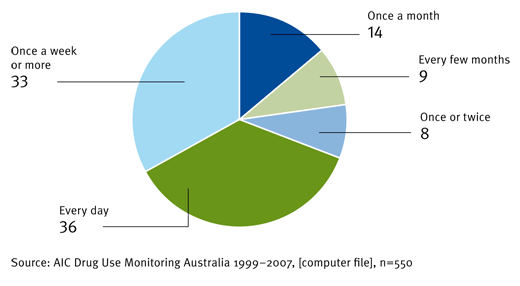Policing and cannabis use in Australia
Julia Tresidder and Carly Shaddock
Key Points
Among the general population:
- Cannabis is the most commonly used illicit drug with one in three Australians (34%) reporting use in their lifetime
- Males are more likely to have used cannabis (37%) than females (30%)
- Recent use of cannabis is most common among those aged 20–29 years
- Eighteen percent of secondary school students have used cannabis and 14 percent report use of cannabis in the past 12 months
Among police detainees:
- Cannabis is the most common illicit drug used by police detainees
- From 1999 to 2007 the Drug Use Monitoring in Australia program data indicated that around 50 to 60 percent of police detainees tested positive to cannabis through urinalysis
- Towards the end of 2007, of a sample of police detainees 53 percent said they used cannabis in the past 12 months. Over two-thirds said they used cannabis once a week or more often
Among offenders on custodial sentences:
- Over 62 percent of men and 49 percent of women surveyed in Australian prisons said they used cannabis in the six months prior to incarceration
- Almost all juveniles surveyed in custody had used cannabis (94%) and 84 percent reported using cannabis in the six months prior to incarceration
Police strategies:
- A significant proportion of offenders who have contact with police are problematic cannabis users. Police can therefore play a role in referral to treatment services
- Police strategies that prevent cannabis-related harm in communities involve partnerships with local agencies such as schools, health services and other relevant community groups
The context
Cannabis is illegal in all states and territories across Australia. Each jurisdiction has legislation relating to the cultivation, supply, possession and use of cannabis. In some jurisdictions, minor cannabis possession offences may be dealt with using civil penalties in particular circumstances. In addition, diversionary schemes are in place in most jurisdictions and minor cannabis offences may be dealt with under these schemes. Cannabis-related penalties and schemes are regularly scrutinised, and legislative and policy changes are quite common.
Despite its illegal status, it is estimated that around one-third (33.5%) of Australians over the age of 14 years report using cannabis at some time in their lifetime. After a noted rise in cannabis use in 1998 among those sampled by the National Drug Strategy Household Survey (NDSHS), when 17.9 percent of respondents reported use in the past 12 months, there was a consistent decline in reported use to 12.9 percent in 2001, 11.3 percent in 2004 and 9.1 percent in 2007. Males (37%) are more likely to report having used cannabis than females (30%). Those aged 20–29 years are the most likely to have used cannabis in the past 12 months with 25.7 percent of young men and 15.9 percent of young women reporting use1 (Figure 1).
The prevalence of reported use suggests that cannabis is often widely available and socially acceptable among some groups. Just over one-quarter of adults (27%) reported in the 2004 NDSHS that they believed cannabis use should be legalised; however, this declined to 21.2 percent in the 2007 survey. In the 2004 NDSHS, 28 percent of respondents reported that they thought possession of a ‘small amount’ of cannabis should be a criminal offence and that offenders should receive a criminal record.2 These apparently contradictory and changing views among the general public about the illicit status of cannabis and consequences for its possession in minor amounts are reflected in the regular debates that arise about this issue.
Since 2001–02 there has been an increase in the proportion of alcohol and other drug treatment episodes where cannabis was reported as the primary drug of concern.3 This may reflect a change in attitude towards cannabis use among the community or a growing subgroup who are finding their cannabis use problematic. The rise in treatment may also be attributed to the growth in programs that seek to divert minor cannabis and cannabis-related offenders into treatment and away from the criminal justice system.
Figure 1
Percentage of the population who reported recent cannabis use by age and sex, 2004 and 2007

Juvenile use
In 2005, a representative sample of 21,805 secondary school students were surveyed on their use of over-the-counter and illicit substances.4 Cannabis use was the most common illicit drug reported by participants. For the entire school sample, 18 percent reported having used cannabis at some time. Use of cannabis increased with age: five percent of 12-year-olds reported use and this increased to 32 percent of 17-year-olds. Use of cannabis in the past 12 months was reported by 14 percent of school students. Seven percent of all students had used cannabis in the month prior to the survey and four percent had used it the week prior to the survey. The percentage of students who used cannabis weekly also increased with age, from 1 percent of 12-year-olds to 6 percent of 17-year-olds. There was a decline in the use of cannabis among school students from 1996 to 2005.
People in contact with police
Figure 2
Percentage of adult police detainees testing positive to cannabis through urinalysis, 1999–2007

Information on the use of cannabis by police detainees in Australia is available through the Drug Use Monitoring in Australia (DUMA) program. The program currently covers nine sites around Australia. Data on drug use and other relevant variables are collected quarterly from each site and are reported annually. Detainees participate in the research on a voluntary basis. Demographic, drug use, drug market and offending data are collected via a questionnaire by a trained independent interviewer. In addition, a urine sample is also taken and tested for seven different classes of drugs. All data collected are confidential and cannot be linked back to the detainee.
Figure 2 depicts the variation in the percentage of police detainees who tested positive to cannabis use through urinalysis from 1999 to 2007. Some of the variation in the last two years may have been due to three extra sites being included over this time frame. There are variations in the data from each site about how many people test positive to cannabis use. This highlights the importance of localised patterns of use and distribution.
In the fourth quarter of 2007, a set of additional questions was asked to find out more about cannabis use among this group. A total of 1,043 police detainees responded to the question relating to recent cannabis use. The 53 percent who reported that they had used cannabis in the past 12 months were then asked additional questions. Of these 550 people, 36 percent reported they used cannabis every day and 33 percent said they used it once a week or more. Fourteen percent reported monthly use (Figure 3). Seventeen percent of this group who had used cannabis in the past 12 months reported they had offended when they were high on cannabis at some time during that period.
Among those detainees interviewed in the fourth quarter of 2007 and who reported having used cannabis in the past 12 months, 17 percent reported being arrested and charged as a result of a cannabis-related offence. Seventy-eight percent reported they had no cannabis-related offences in this time. Others reported being issued with a warning (4%), participating in a cannabis education session (2%), having an assessment for their cannabis use (2%) and participating in treatment for cannabis use (2%).
Police detainees who are aged less than 36 years are more likely to have used cannabis in the past 12 months than older police detainees. In 2006 around 60 percent of police detainees aged 18–35 years tested positive to cannabis. Recent use declined amongst those over 36 years of age (40% of men and 36% of women).5
Figure 3
Frequency of cannabis use by police detainees interviewed in the fourth quarter of 2007 who reported using cannabis in the past 12 months (percentage)

Reported cannabis use among offenders on custodial sentences
Adult prisoners
Some of the people detained by police are serious and often recidivist offenders. Many people in custody have complex needs and their cannabis use is only one issue among many that may contribute to their offending behaviour. More information about these people is available from a survey conducted in 2000–01 of 2,135 adult men in prisons in Queensland, Western Australia, Tasmania and the Northern Territory,6 and a 2003 survey of 470 women incarcerated in prisons throughout Australia.7 Cannabis was the most common illicit drug ever used by both men (81%) and women (78%) and was also the most common illegal drug used regularly during the six months prior to their most recent arrest (62% of men and 49% of women). Fifty-three percent of men and 40 percent of women reported current regular use of cannabis six months prior to detention. Thirty percent of women reported they were intoxicated as a result of cannabis use at the time of their last offence. The percentage of men in prison who reported being intoxicated by cannabis at the time of their last offence was not specified; however, 24 percent reported being high on illegal drugs and 17 percent reported being intoxicated by both alcohol and illegal drugs.
Juveniles in detention centres
A survey of 371 juveniles in Australian detention centres was conducted in 2003–04. The participants were between 10 and 17 years of age, the average age was 16 and 93 percent were males. Over half of the juveniles identified themselves as Indigenous (59%). This survey indicated that almost all participants had used cannabis (94%) at least once.8 More than four in every five juveniles (84%) reported use of cannabis in the six months prior to their detention and 46 percent said they had used cannabis regularly. When asked about their last offence, 48 percent said they were under the influence of drugs, and of these juveniles, three-quarters said they were intoxicated as a result of their cannabis use prior to committing the offence.
Implications for policing
While just over half of people who are detained by police report using cannabis in the past 12 months, less than one in five of these people report having been charged with a cannabis offence in the same period. The proportion who report using cannabis in the six months prior to entering prison is also high with half of women and almost two-thirds of men having used cannabis recently. Among juveniles in detention cannabis use in the past six months was reported by over four out of every five respondents. This reporting of recent use among those who come into contact with police is much higher than the proportion of the general population who report using cannabis in the past 12 months. This indicates that many offenders may have problematic cannabis use. Analysis of adolescent treatment samples also shows such an association between cannabis use and offending behaviour.9
Cannabis police diversion programs
Reactive intervention strategies such as diversion to drug education, assessment and treatment are part of police practice in Australia. For those already using cannabis and experiencing problems with their use, police can provide information about treatment options and this may help users to seek treatment.10 Informing families and community groups about options for treatment may also influence those with cannabis use problems to access assistance.
Police diversion programs target those who are found with minor amounts of cannabis in their possession. Programs in each state and territory assist police and provide those people apprehended for minor infringements an opportunity to address their cannabis use through contact with appropriate drug education or a treatment agency. Diversion programs that address drug-related offending are located at the level of pre-court and court diversion programs. Drug diversion programs and treatment options will be addressed in a future NCPIC Bulletin in the criminal justice issues series.
Key ‘whole-of-community’ strategies
Overall, police have an important role in communities to reduce cannabis use. This contributes to the Australian National Drug Strategy’s three goals of demand reduction, harm reduction and supply reduction. The strategies police use will depend on their community setting. Police can gain a local picture of the main issues in their community by analysing their local environment and taking into account both policing and health data.11
Proactive policing within community settings includes strategies to raise awareness of the risks and potential negative consequences associated with cannabis use among groups in the community. Raising awareness about the legal consequences of possession of cannabis may deter some people from initiating cannabis use.
Partnerships between police and other agencies in the community can help ensure appropriate crime prevention strategies are in place that may assist to reduce demand for cannabis.
Effective policing styles
Recent research compared the effectiveness of different styles of policing in relation to drug law enforcement at a street level. This work looked at the relative impact of these styles on street-level drug problems as well as associated problems such as property crime, disorder and violent crime.12
The research review found that problem-oriented policing and geographically focussed interventions with cooperative partnerships between police and third parties are more effective than less-focussed community-wide policing strategies. However, geographic and community-wide interventions that take advantage of partnerships are more effective than standard, unfocused law enforcement efforts.
A key to the success of drug law enforcement is in the capacity of the police being able to establish and evolve effective partnerships with other groups in the community rather than simply to increase police activity or focus on arrests at drug hotspots.
Conclusion
Cannabis is the most commonly used illicit drug in Australia. The community's views about cannabis use are divided. There is a range of approaches to drug law enforcement regarding minor possession and personal use of cannabis. Surveys of police detainees and those incarcerated show that cannabis use is more prevalent among these groups than the general community.
Police strategies that involve proactive policing and include effective partnerships with other stakeholders in their local community may be the most effective strategies in regards to drug law enforcement. Police can play a key role within their local communities to lessen the harms from cannabis use.
References
- Australian Institute of Health and Welfare. (2008). 2007 National Drug Strategy Household Survey: First results. AIHW cat. no. PHE 98. Canberra: Australian Institute of Health and Welfare.
- Australian Institute of Health and Welfare. (2005). 2004 National Drug Strategy Household Survey: Detailed findings. AIHW cat. no. PHE 66. Canberra: Australian Institute of Health and Welfare.
- Australian Institute of Health and Welfare. (2007). Alcohol and other drug treatment services in Australia 2005-06. Report on the National Minimum Data Set Drug Treatment. Series No. 7. Canberra: Australian Institute of Health and Welfare.
- White, V. & Hayman, J. (2006). Australian secondary school students’ use of over-the-counter and illicit substances in 2005. Melbourne: The Cancer Council of Victoria.
- Mouzos, J., Hind, N., Smith, L., & Adams, K. (2007). Drug use monitoring Australia: 2006 annual report on drug use among police detainees. Research and Public Policy Series No. 75. Canberra: Australian Institute of Criminology.
- Makkai, T. & Payne, J. (2003). Drugs and crime: a study of incarcerated male offenders. Research and Public Policy Series. No. 52. Canberra: Australian Institute of Criminology.
- Johnson, H. (2004). Key findings from the Drug Use Careers of Female Offenders Study. Trends and Issues in Crime and Criminal Justice. No. 289. Canberra: Australian Institute of Criminology.
- Prichard, J. & Payne, J. (2005). Key findings from the Drug Use Careers of Juvenile Offenders study. Trends and Issues in Crime and Criminal Justice. No. 304. Canberra: Australian Institute of Criminology.
- Acuri, A., Copeland, J. & Howard, J. (2008). Clinical profiles of cannabis-dependent adolescents in residential substance use treatment. NCPIC Bulletin Series No. 1. Sydney: National Cannabis Prevention and Information Centre.
- Klag, S., O’Callaghan, F. & Creed, P. (2005). The use of legal coercion in the treatment of substance abusers. An overview and critical analysis of thirty years of research. Substance Use and Misuse 40, 1777-1795.
- Dehahunty, B. & Putt, J. (2006). Good practice framework: policing illicit drugs in rural and remote Aboriginal and Torres Strait Islander communities. Monograph Series No. 15. National Drug Law Enforcement Research Fund.
- Mazerolle, L., Soole, D.W. & Rombouts, S. (2006). Street-level drug law enforcement: A meta analytical review. Journal of Experimental Criminology 2, 409-435.














































